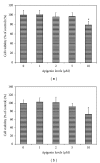Subtoxic Levels of Apigenin Inhibit Expression and Secretion of VEGF by Uveal Melanoma Cells via Suppression of ERK1/2 and PI3K/Akt Pathways
- PMID: 24288566
- PMCID: PMC3833119
- DOI: 10.1155/2013/817674
Subtoxic Levels of Apigenin Inhibit Expression and Secretion of VEGF by Uveal Melanoma Cells via Suppression of ERK1/2 and PI3K/Akt Pathways
Abstract
The effects of apigenin on the expression of VEGF in uveal melanoma cells have not been reported. We studied this effect and relevant signaling pathways in two human uveal melanoma cell lines (SP6.5 and C918). ELISA assay revealed that the constitutive secretion of VEGF by uveal melanoma cells was 21-fold higher than that in normal uveal melanocytes. Apigenin at subtoxic levels (1-5 μ M) significantly suppressed the secretion of VEGF in a dose- and time-dependent manner in melanoma cells. VEGF levels in the conditioned culture media from SP6.5 and C918 cell lines treated with 5 μ M apigenin for 24 h reduced to 29% and 21% of those in cells not treated with apigenin, respectively. RT-PCR analysis found that apigenin also decreased the expression of VEGF mRNA in melanoma cells. ELISA study of various signal pathways showed that apigenin significantly decreased phosphorylated Akt and ERK1/2 but increased phosphorylated JNK1/2 and p38 MAPK levels in melanoma cells. PI3K/Akt or ERK1/2 inhibitors significantly decreased, but JNK1/2 and p38 MAPK inhibitors did not influence the secretion of VEGF by melanoma cells, suggesting that apigenin suppresses the secretion of VEGF mainly through the inhibition of PI3K/Akt and ERK1/2 pathways.
Figures






Similar articles
-
Uveal melanocytes express high constitutive levels of MMP-8 which can be upregulated by TNF-α via the MAPK pathway.Exp Eye Res. 2018 Oct;175:181-191. doi: 10.1016/j.exer.2018.06.023. Epub 2018 Jun 22. Exp Eye Res. 2018. PMID: 29935949
-
Zeaxanthin Induces Apoptosis in Human Uveal Melanoma Cells through Bcl-2 Family Proteins and Intrinsic Apoptosis Pathway.Evid Based Complement Alternat Med. 2013;2013:205082. doi: 10.1155/2013/205082. Epub 2013 Oct 10. Evid Based Complement Alternat Med. 2013. PMID: 24223611 Free PMC article.
-
The PI3K/Akt and mTOR/P70S6K signaling pathways in human uveal melanoma cells: interaction with B-Raf/ERK.Invest Ophthalmol Vis Sci. 2010 Jan;51(1):421-9. doi: 10.1167/iovs.09-3974. Epub 2009 Aug 6. Invest Ophthalmol Vis Sci. 2010. PMID: 19661225
-
NGF increases VEGF expression and promotes cell proliferation via ERK1/2 and AKT signaling in Müller cells.Mol Vis. 2016 Mar 25;22:254-63. eCollection 2016. Mol Vis. 2016. PMID: 27081296 Free PMC article.
-
VEGF Production Is Regulated by the AKT/ERK1/2 Signaling Pathway and Controls the Proliferation of Toxoplasma gondii in ARPE-19 Cells.Front Cell Infect Microbiol. 2020 Apr 28;10:184. doi: 10.3389/fcimb.2020.00184. eCollection 2020. Front Cell Infect Microbiol. 2020. PMID: 32432052 Free PMC article.
Cited by
-
Impact of Plant-Derived Flavonoids on Neurodegenerative Diseases.Neurotox Res. 2016 Jul;30(1):41-52. doi: 10.1007/s12640-016-9600-1. Epub 2016 Mar 7. Neurotox Res. 2016. PMID: 26951456 Review.
-
Circ_0032821 acts as an oncogene in cell proliferation, metastasis and autophagy in human gastric cancer cells in vitro and in vivo through activating MEK1/ERK1/2 signaling pathway.Cancer Cell Int. 2020 Mar 6;20:74. doi: 10.1186/s12935-020-1151-0. eCollection 2020. Cancer Cell Int. 2020. PMID: 32165864 Free PMC article.
-
Apigetrin inhibits adipogenesis in 3T3-L1 cells by downregulating PPARγ and CEBP-α.Lipids Health Dis. 2018 Apr 25;17(1):95. doi: 10.1186/s12944-018-0738-0. Lipids Health Dis. 2018. PMID: 29695233 Free PMC article.
-
Phytochemicals for the Management of Melanoma.Mini Rev Med Chem. 2016;16(12):953-79. doi: 10.2174/1389557516666160211120157. Mini Rev Med Chem. 2016. PMID: 26864554 Free PMC article. Review.
-
Epigallocatechingallate inhibits migration of human uveal melanoma cells via downregulation of matrix metalloproteinase-2 activity and ERK1/2 pathway.Biomed Res Int. 2014;2014:141582. doi: 10.1155/2014/141582. Epub 2014 Aug 12. Biomed Res Int. 2014. PMID: 25184134 Free PMC article.
References
-
- Hu DN, Yu GP, McCormick SA, Schneider S, Finger PT. Population-based incidence of uveal melanoma in various races and ethnic groups. American Journal of Ophthalmology. 2005;140(4):612–617. - PubMed
-
- Kujala E, Mäkitie T, Kivelä T. Very long-term prognosis of patients with malignant uveal melanoma. Investigative Ophthalmology and Visual Science. 2003;44(11):4651–4659. - PubMed
-
- Augsburger JJ, Corrêa ZM, Shaikh AH. Effectiveness of treatments for metastatic uveal melanoma. American Journal of Ophthalmology. 2009;148(1):119–127. - PubMed
-
- Xie K, Wei D, Shi Q, Huang S. Constitutive and inducible expression and regulation of vascular endothelial growth factor. Cytokine and Growth Factor Reviews. 2004;15(5):297–324. - PubMed
-
- Loureiro RMB, D’Amore PA. Transcriptional regulation of vascular endothelial growth factor in cancer. Cytokine and Growth Factor Reviews. 2005;16(1):77–89. - PubMed
LinkOut - more resources
Full Text Sources
Other Literature Sources
Research Materials
Miscellaneous

